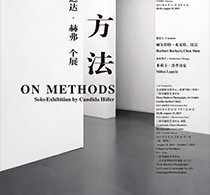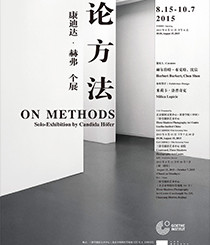Presented by: Three Shadows Photography Art Centre, Goethe-Institut China
Opening: 18:00, August 15, 2015
Venue: Three Shadows Photography Art Centre (Caochangdi No. 155, Chaoyang District, Beijing)
Film Screening Time: 19:30, August 15, 2015
Film Screening Venue: Courtyard, Three Shadows Photography Art Centre
Exhibition Period: August 15, 2015 – October 7, 2015 (Closed on Mondays)
Curator: Herbert Burkert, Chen Shen
Exhibition Design: Milica Lopicic
On Methods – Solo-Exhibition by Candida Höfer
The Goethe-Institut China and Three Shadows Photography Art Centre are pleased to present the first solo-exhibition by Candida Höfer in Beijing. This exhibition entitled “On Methods” is the first comprehensive public display of her work in China and gives the public an insight into the development and diversity of her photographic working methods.
Candida Höfer is one of the most well-known artists working with photography worldwide. Born in 1944 in Eberswalde, Germany, she studied at the Kunstakademie Düsseldorf, at first film with Ole John, then photography with Bernd Becher. Her work is shown in museums including the Kunsthalle Basel, the Kunsthalle Berne, the Portikus, Frankfurt am Main, the Museum of Modern Art, New York, the Power Plant, Toronto, the Kunsthaus Bregenz, and the Museum Ludwig, Cologne. In 2002 Candida Höfer participated in documenta 11. In 2003 she represented Germany at the Biennale in Venice (together with the late Martin Kippenberger). In 2013 the artist had a solo show at the Museum Kunstpalast Düsseldorf and in 2015 at the Ermitage, St.Petersburg. Candida Höfer lives in Cologne.
“On Methods” provides an overview of Höfer’s various uses of photography as an art form and her different methodic approaches turning photographs into images, balancing the distance of the photographic apparatus with her empathic understanding of the relationship between light, forms and colors that give character to spaces.
In the exhibition there are photographs from one of her first projects, Turkish workers in Germany, from the mid-1970s, as well as street scenes in Düsseldorf from about the same period. We encounter early images of interiors that she still had taken with a handheld camera – including images from China. We see examples of her large format, highly detailed portraits of spaces for which she has become famous, cultural spaces without people making visible what spaces do for people and what people do to spaces. Besides, the exhibition will present her current approach (again including examples from China) where – returning to the ease and flexibility of a small camera – she dedicates herself to the less obvious details of our surroundings.
“There is a method to take the photograph; there is a method to make the image; and there is a method to present the picture. Candida Höfer has often emphasized the equal importance of all of these three distinct phases in her production.” (Herbert Burkert, one of the curators of the exhibition). Having at least touched filmmaking in her early studies, the moving image, although at the slow speed of slide shows, has always remained important to her and is represented with several projection examples in this show.
“On Methods” will open in the presence of the artist on August 15th at Three Shadows Photography Art Centre and last till October 7th, 2015.
PROGRAMME
On Methods –
Solo-Exhibition by Candida Höfer
Presented by: Three Shadows Photography Art Centre, Goethe-Institut China
Opening: 15.08.2015, 18:00
Exhibition Period: 16.08.2015 – 07.10.2015, Tuesday – Sunday, 10:00 – 18:00
Venue: Three Shadows Photography Art Centre (Caochangdi No. 155, Chaoyang District, Beijing)
Curators: Herbert Burkert, Shen Chen
Film Screening “Silent Space“
Time: 15.08.2015, 19:30 – 20:45
Venue: Three Shadows Photography Art Center
The Portuguese filmmaker Rui Xavier spent two years shadowing Candida Höfer. He follows Candida Höfer while she is photographing, when she is working in her studio and at home, as well as in the preparation of exhibitions in Düsseldorf, London and São Paulo. “Silent Spaces” is a visual series of observations and variations on Candida Höfer’s creative work process and artistic approach. The result is a dense filmic portrait of the artist, which manages without words, trusting in its own visual language.
ABOUT THE ARTIST
Born in Eberswalde (Germany) Candida Höfer studied at the Kunstakademie Düsseldorf, initially film with Ole John, then photography with Bernd Becher. Her work is shown in museums including the Kunsthalle Basel, the Kunsthalle Berne, the Portikus, Frankfurt am Main, the Museum of Modern Art, New York, the Power Plant, Toronto, the Kunsthaus Bregenz, and the Museum Ludwig, Cologne. In 2002 Candida Höfer participated in documenta 11. In 2003 she represented Germany at the Biennale in Venice (together with the late Martin Kippenberger). In 2013 the artist had a solo show at the Museum Kunstpalast Düsseldorf and in 2015 at the Ermitage, St.Petersburg. Candida Höfer lives in Cologne.
TEXT/ Chen Shen
Owing to its ability to provide an accurate depiction all manner of things in the real world, during the early days of its emergence, photography caused a panic amongst a portion of the realist school of painters. In 1839, after laying his eyes on a Daguerreotype for the first time, Paul Delaroche declared “Painting is dead.” Today, 176 years later, the history of art is ever changing and when viewers stand before Candida Höfer’s Deutsche Oper am Rhein Dusseldorf I 2012, a work exceeding 2.5 meters in length, perhaps they won’t sigh with the same emotional sentiments as Delaroche, but it’s nearly impossible not to be moved by the energy permeating the piece and the intense visual assault of the rows upon rows of bright red seats. Viewers also decidedly experience the psychological shock of a photograph so brimming with detail and an exquisite use of light.
Candida Höfer was born in Eberswalde, Germany in 1944. After graduating from the Cologne Academy of Fine and Applied Arts, she worked for various photographers and press offices before studying film and photography at the Kunstakademie Düsseldorf from 1973‐1982. The 1960s and 1970s were the most critical period in the development of the history of photography. On the western shores of the Atlantic Ocean, William Eggleston’s color photographs were exhibited for the first time at New York’s Museum of Modern Art in 1976, adding gorgeous color to the history of photography. Ed Ruscha, John Baldessari and others, began using photography as their medium to produce conceptual art, thus encouraging photography’s gradual acceptance into the mainstream art world. Far across the ocean from North America, on the banks of the Rhine in Düsseldorf, Germany, Bernd and Hilla Becher, together with their pupils, formed “The Düsseldorf School”, one of the most important and influential artistic groups in the global history of photography. Candida Höfer is the most prominent representative among the first class of the Bechers’ students.
After completing a series about immigrant workers in Germany, Candida Höfer shifted her focus to photographing interior spaces. In libraries, museums, palaces, and a multitude of other architectural structures, she utilized a large‐format camera with strong axial mobility and a wide‐angle lens, thus allowing the resultant frame to present a truly objective state. The camera is situated at a height that allowed it to overlook the entirety of the space. By simultaneously employing the natural light
coming through the windows into the structure, as well as the man‐made lighting of the interior
space itself, the composition presents the utmost symmetry. The format of the works is monumental (akin to the work of her colleagues in the Düsseldorf School), rich in detail, ripe with a sense of order and sequence. Human existence has been eliminated from the scene, with a characteristic “deadpan” presentation. As such, we see that interior architecture is not merely a square box made of concrete and marble. It bears the weight of practical function, manifesting a cultural, documentary history, serving as a significant vehicle for memory, and fulfilling the warm promise of Zeitgeist. A benefit of the artist’s creation of such large‐scale works is that viewers are not only able to actually conduct an in‐depth investigation of the details, but also they enter into a particular type of dialogue with the scene and space presented in the piece. This dialogue isn’t the sort where the viewer themselves necessarily easily enters the space, but owing to the extremely tranquil and removed ambiance of
the work, it’s quite possible that they wouldn’t dare to abruptly disrupt, thus avoiding the risk of a hopeless dilemma. Hence, objective presentation and subjective psychological activity or emotion become linked together—consistently, when faced with these sorts of scenes, the emotions that are activated and the imagination that is stimulated for eastern and western audiences are extremely different. In an interview, Candida Höfer once stated: “To me these spaces have their own character and vitality, revealing in their displays the layers of time and the experiences through which they
have come to be what they are, and they seem to resist such changes…I probably emphasize a sort of ‘permanent process of negotiation’ between space and its uses over time, but also more basically between light and space.”1
Even those audiences who have grown accustomed to looking at Candida Höfer’s large‐scale works may be surprised by a series of work completed in 2014‐15. In contrast to previous works, it appears Candida has returned to the period in which she had just entered the Kunstakademie Düsseldorf; the artist’s previously precise, symmetrical composition has been destroyed (actually, in the subtleties of the work we can still witness the artist exerting exacting control over the composition). The work once more returns its focus to detailed particulars, rather than the depiction of immense scenes. From the audience perspective, the everyday things presented in the frame may leave us uncertain of what to do. But at the same time, the attentive audience will find that the titles of the works are no longer referring to locales, but rather employ a mode of nomenclature reminding us “problem of universals”, such as Pedestals 2015, Clothes 2015, and Shadows 2015. Perhaps it is as Bertrand Russell states in his The Problems of Philosophy, our understanding of an artist’s work serves an enlightening purpose: “these questions enlarge our conception of what is possible, enrich our intellectual imagination and diminish the dogmatic assurance which closes the mind against speculation.”2
“On Methods”, this Candida Höfer solo exhibition at Three Shadows Photography Art Centre, is comprised of works produced over the lengthy span of 41 years (from 1974 to 2015). The exhibition features not only those photographs completed while studying in Düsseldorf, but also recent works shot in China; the exhibition presents both the artist’s highly renowned large‐format photographs, as well as smaller, meticulously detailed pieces. The exhibition features both prints and projections, allowing Chinese audiences to enjoy a comprehensive understanding of the progression of her artistic methodologies throughout the course of her career.
1) Hofer interviewed by Ludovico Pratesi, © Fundación Proa and Ediciones Larivière, Buenos Aires, 2009.
2) Russell, Bertrand. The Problems of Philosophy, The Commercial Press, April 2007 First Edition, P133.


